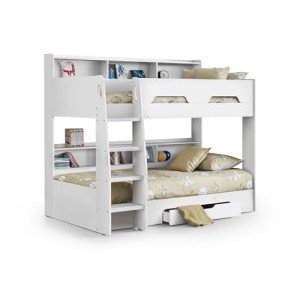Exploring Bunk Beds: A Comprehensive Guide
Bunk beds have long been a staple in children's bedrooms, dorms, and even homes with restricted space. Not only do they offer a practical sleeping service, however they also produce an enjoyable and imaginative environment for kids and a great space-saver for adults and families. This short article will explore everything you require to understand about bunk beds, from types and products to security pointers and purchasing suggestions.
Tabulation
- Kinds Of Bunk Beds
- Standard Bunk Beds
- Loft Beds
- Triple Bunk Beds
- L-Shaped Bunk Beds
- Material Options
- Wood
- Metal
- Safety Considerations
- Purchasing Guide
- FAQs
Types of Bunk Beds
Bunk beds can be found in various designs to match different requirements and preferences. Here's a breakdown of the most typical types:
Conventional Bunk Beds
Standard bunks generally feature two beds stacked vertically on top of one another. These beds are perfect for brother or sisters sharing a room or for making the most of sleeping space in guest rooms.
Loft Beds
Loft beds stand likewise to standard bunk beds but do not have a lower sleeping area. Rather, they frequently include a desk or seating area below, making them a great choice for little rooms requiring multifunctionality.
Triple Bunk Beds
Triple bunk beds cheap beds are developed for three occupants, with beds stacked in a three-tier configuration. These are less typical but can be a fun service for large households or sleepovers.
L-Shaped Bunk Beds
With one bed placed horizontally and the other vertically, L-shaped bunk beds are typically geared up with additional features such as desks or storage drawers and can complement corner spaces in a space.

Comparison of Bunk Bed Types
| Bed Type | Ideal Use | Description |
|---|---|---|
| Traditional | Shared bed rooms or visitor rooms | 2 beds stacked vertically |
| Loft | Little spaces requiring multi-purpose space | Upper bed with open space below |
| Triple | Big households or sleepovers | Three beds stacked vertically |
| L-Shaped | Corner or flexible spaces | A mix of vertical and horizontal beds |
Product Options
Bunk beds are manufactured from different products, with wood and metal being the most common. Each product has its benefits and drawbacks.
Wood
- Resilience: Generally robust and can hold up against years of use.
- Aesthetic Appeal: Offers a timeless look that can mix with different designs.
- Weight Capacity: Typically tougher; can support much heavier weights.
- Downsides: May be more costly than metal choices and can be vulnerable to scratches.
Metal
- Toughness: Generally light-weight and simple to move however still sturdy.
- Modern Design: Often is available in smooth styles, making it appealing for modern spaces.
- Cost-Effective: Usually less costly than wood choices.
- Disadvantages: Can be cold to the touch in winters and might not have the same visual appeal for some buyers.
Safety Considerations
When it concerns bunk beds, safety can not be ignored. Here are crucial security ideas to remember:
- Guardrails: Ensure that the top bunk has guardrails on both sides to prevent falls.
- Strong Construction: Check for a solid build and sturdy materials to withstand weight and motion.
- Weight Limit: Adhere to the producer's weight limit for both the upper and lower bunks.
- Ladder Design: Choose bunks with a safe, easy-to-climb ladder and avoid any sharp edges or rungs.
- Age Restrictions: Most producers suggest that children under the age of six ought to not oversleep the upper bunk beds near me.
Purchasing Guide
When shopping for bunk beds sale beds, think about the list below aspects to find the best suitable for your needs:

- Space Availability: Measure the room size and ceiling height, making sure there is adequate space for the top bunk.
- Bed Size: Decide between twin, full, or bigger sizes based upon your needs and the size of the room.
- Design Preference: Consider the total design of the bed room to find an ideal style.
- Reduce of Setup: Look for a bunk beds uk bed that is straightforward to put together.
- Budget plan: Bunk beds can be found in numerous price ranges, so determine a budget before beginning your search.
Frequently asked questions
1. What is the suggested age for children to sleep on the leading bunk?
Children aged 6 and older are usually suggested to sleep on the top bunk to lessen the danger of falls.
2. How can I make my bunk bed safer?
To improve safety, ensure guardrails are correctly set up and examine that the bed is put on a flat surface area. Additionally, encourage children to use the ladder carefully.
3. Can I transform a bunk bed into 2 separate beds?
Many bunk beds are created to be convertible. Check the maker's specs for convertibility functions.
4. What devices are offered for bunk beds?
Common accessories consist of beddings, storage drawers, staircases rather of ladders, and tented canopies for a fun visual appeal.
5. How do I keep my bunk bed?
Routine look for loose screws or structural stability can help guarantee security. Dust the bed frequently and tidy spills quickly to keep the products in good condition.
Bunk beds are versatile and a space-efficient option for various living circumstances, from kids's rooms to guest lodgings. With many designs and products available, potential buyers have a wealth of options to consider, guaranteeing a combination of practicality and visual appeals. By prioritizing security and following the pointers described in this guide, people can find the ideal bunk bed that fits their space and lifestyle, all while producing a satisfying sleeping environment.








